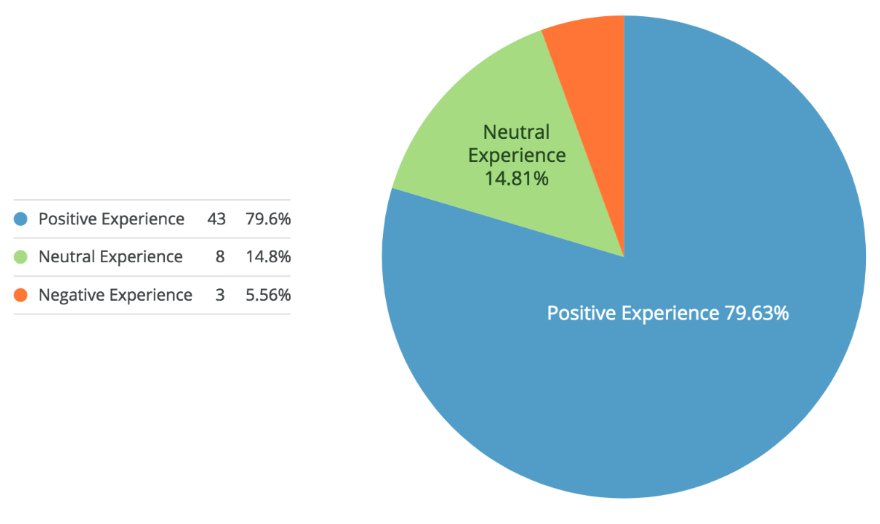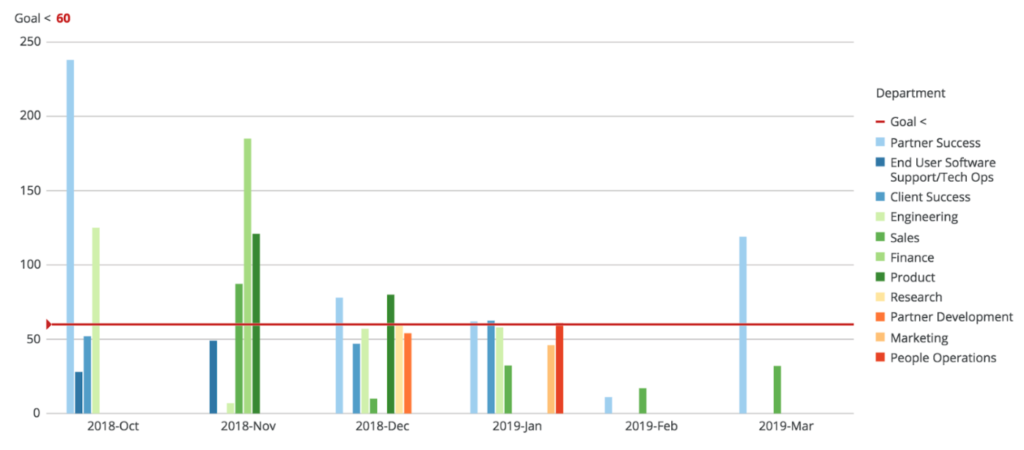Most organizations are tracking something—whether it’s revenue, customer retention, operating productivity, or another common business metric.
What most organizations aren’t tracking are metrics related to their talent and people. Considering people are often an organization’s largest expense, this is a missed opportunity.
Take a look at some of the recruiting metrics we track here at The Predictive Index® to hire effectively, reduce turnover, and maintain a strong employer brand.
Candidate experience
Why it matters
Candidate experience plays a key role in employee engagement. If a candidate has a great experience and later accepts a job offer, they’re much more likely to become a highly engaged member of the team as opposed to someone who didn’t quite as positive a candidate experience. Someone who has a more positive experience will likely feel connected to the company culture and truly understand the mission and vision that drive your organization.
In addition to improving employee engagement, candidate experience also impacts your employer brand. If someone interviews but is not offered a job, a positive experience will allow them to not only apply for positions in the future with excitement, but also spread the word about how awesome the organization is.
How to measure it
As part of your hiring process, encourage candidates to complete a survey about their experience. Here at PI, our candidate surveys are automatically sent from our applicant tracking system (ATS) to any candidate that reaches our final round of interviews—an on-site “Super Day.” This way, we’re comparing candidates who’ve completed the same process.
Be sure to include a section in your survey for candidates to leave comments on what they would change about your process. These comments can help fine tune your process to create a better candidate experience and lead to more positive reviews of your organization.

Time to fill
Why it matters
We’ve all felt the pain of positions that just never seem to close. Simply put, vacant roles put a major strain on business. Progress is halted, current employees work harder to compensate for the vacancy, and even the customer can feel the impact of the open position. Tracking time to fill can provide valuable insights to recruiters and hiring managers, highlighting inefficiencies that need to be addressed.
How to measure it
Count the number of days between the day the position opened and the day an offer was accepted. Here at PI, we have an automated report that’s run weekly from our ATS and pulled into Domo, a business intelligence and data visualization platform. From there, we can see how our time to fill is changing each week and tweak our approach to decrease our time to fill.

Cost to hire
Why it matters
How much you spend is an important metric to track—regardless of which department you work in. What you spend to acquire new talent is no different. Knowing this number can allow your team to make smarter investment decisions and measure the effectiveness of your recruiters. It also allows you to accurately report on the ROI of recruitment.
How to measure it
Add up all expenses related to recruiting. Divide that number by the total number of hires you’ve made.
Common components of recruiting cost:
- Recruiting agency fees
- Advertising
- Recruiter salaries
- Employee time spent sourcing, reviewing applications, and interviewing candidates
- Cost of your applicant tracking system
- Employee referral bonuses
Interview scorecard ratings
Why it matters
High-performing teams play a critical role in your organization’s success. How do you ensure new hires will mesh with and improve upon existing teams? Interview scorecards can be helpful in this process. They allow teams to gather feedback during the interview process.
These scorecards help employers see if initial impressions of a candidate were correct and provide insight about any red flags that might need to be brought up when interviewing for a position in the future. The scorecards also allow hiring teams to see which interviewers consistently hit the mark when it comes to assessing talent so they can play a more integral role on the interviewing team moving forward.
How to measure it
We record and track interview scorecards through Greenhouse, our applicant tracking system. Whenever a candidate is scheduled for an interview, the interviewer is required to fill out a scorecard within 24 hours. The scorecard is then attached to the candidate’s profile and considered when determining if the candidate should move to the next round of interviews or be offered the position.
Offer-to-accept ratio
Why it matters
Your offer-to-accept ratio can provide useful insight about your employer brand and recruiting process. While occasionally candidates will decline an offer for personal reasons, they may be declining because of your employer brand or candidate experience. The acceptance rate can help to highlight areas in your business that need to change, such as compensation or culture.
How to measure it
Take the total number of offers that have been accepted and divide that by the total number of candidates who have been offered positions at your organization. Multiply this number by 100 and you’ll have the percentage of candidates that accept your offers.

Quality of hire
Why it matters
A mis-hire can cost your organization dearly. Defining and measuring what a quality hire looks like can help you hire the right candidates—reducing turnover costs and increasing performance. Quality hires will reach full productivity more quickly and can help recoup hiring costs in less time.
How to measure it
Establish and define how you’ll measure employee performance. One way to do this is by establishing performance metrics for a role prior to hiring, then measuring against those metrics once an employee reaches the 90-day mark. Use this data to see if the employee has met or exceeded their goals or needs improvement in certain areas. If new hires are falling short of their goals more often than they meet or exceed them, consider revising those goals or your approach to recruitment and hiring.
Want to keep a pulse on employee performance? Download our quality of hire template.
Join 10,000 companies solving the most complex people problems with PI.
Hire the right people, inspire their best work, design dream teams, and sustain engagement for the long haul.








